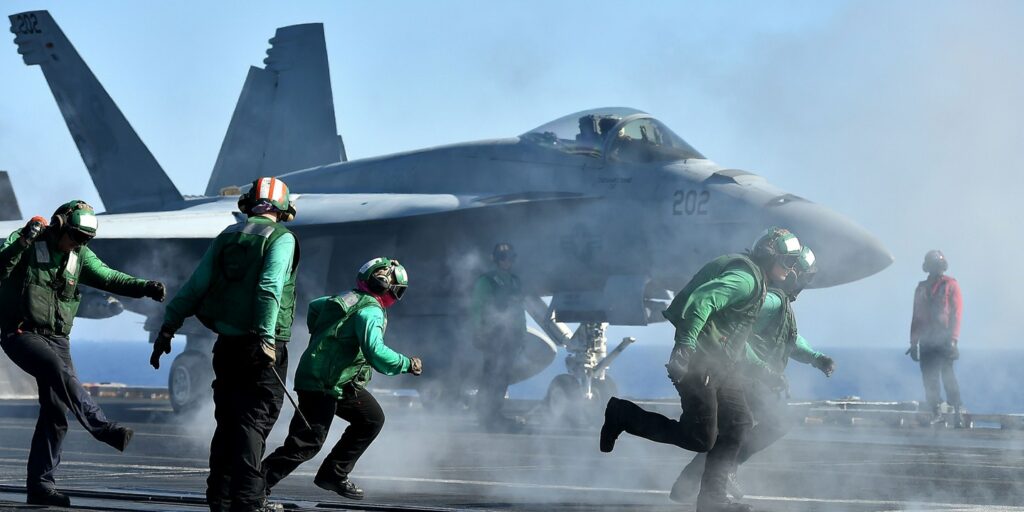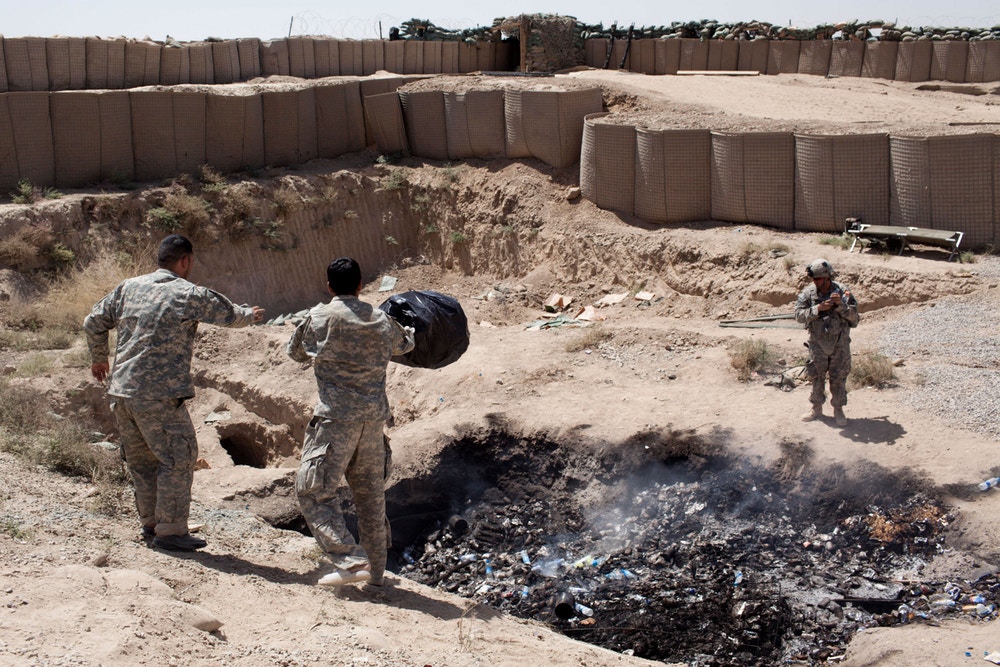War on the World: Industrialized Militaries Are a Bigger Part of the Climate Emergency Than You Know
ANGLO AMERICA, WEAPONS OF MASS DESTRUCTION, MILITARISM, ENVIRONMENT, 16 Sep 2019
Murtaza Hussain – The Interept

Sailors get ready around an F/A-18E Super Hornet on the US Navy’s super carrier USS Dwight D. Eisenhower in the Mediterranean Sea on July 6, 2016. Alberto Pizzoli/AFP/Getty Images
15 Sep 2019 – Over a century before we reached the brink of ecological catastrophe, Rabindranath Tagore had a glimpse of where we might be headed. Tagore, an Indian author and cultural reformer who lived during the period of British colonialism, was among the last of a generation able to examine the industrialized world from the outside. He issued one of the earliest and most eloquent warnings about the precarity of a world sustained, like ours today, on the twin pillars of industrial consumption and industrial warfare. On a sea voyage to Japan in 1916, Tagore witnessed an unfathomable event that seems almost mundane to us today: an oil spill. To him, it was a jarring image of an earth destroyed by humanity’s unbridled pursuit of power, now supercharged by the tools of modern science.
“Before this political civilization came to its power and opened its hungry jaws wide enough to gulp down great continents of the earth,” Tagore wrote in “On Nationalism,” his 1917 book of essays, “we had wars, pillages, changes of monarchy and consequent miseries. But never such a sight of fearful and hopeless voracity, such wholesale feeding of nation upon nation, such huge machines for turning great portions of the earth into mincemeat, never such terrible jealousies with all their ugly teeth and claws ready for tearing open each other’s vitals.”
The climate emergency we are tipping into today — the tearing open of our mutual vitals — is a product of our collective failure to adhere to limits. An economic system that demanded endless growth and endless consumption was always too much to ask from a planet whose resources are finite. Yet, as Tagore recognized, the same avarice and contempt that led us to war against the earth would also lead to catastrophic, endless wars among peoples. At the time of his writing, World War I was underway. Tagore saw that conflict as the first of the modern wars that showed us the great power we had gained to destroy the natural world along with our fellow humans. The massive military industries created during that conflict pointed to an even more inhuman future that might be in store.
It may not come as a surprise that the largest industrial military in the history of the world is also the single biggest polluter on the planet.
“The gigantic organizations for hurting others and warding off their blows, for making money by dragging others back, will not help us,” Tagore wrote. “On the contrary, by their crushing weight, their enormous cost, and their deadening effect upon the living humanity, they will seriously impede our freedom.”
Until his death in 1940, Tagore wrote about the dangers of militarism, race hatred, and a brutal type of industrial development that had begun to disfigure the natural world. The industrialization of warfare has now given us powers to destroy other human beings and the earth itself on a scale surpassing even Tagore’s warnings. Even those whose lives have been dedicated to the project of American militarism have begun to recognize the destruction being wrought. In the era of climate crisis, the relationship between environmental destruction and the destruction of human life that Tagore decried in his writings has become perhaps the central issue of our time.
It may not come as a surprise that the largest industrial military in the history of the world is also the single biggest polluter on the planet. A recent study from Brown University’s Costs of War project surfaced this startling fact: The U.S. Department of Defense has a larger annual carbon footprint than most countries on earth. With a sprawling network of bases and logistics networks, the U.S. military is the single biggest emitter of carbon dioxide in the world aside from whole nation-states themselves. “Indeed, the DOD is the world’s largest institutional user of petroleum and correspondingly, the single largest producer of greenhouse gases in the world,” the report notes. If the Pentagon were a country, it would be the world’s 55th biggest emitter of carbon dioxide. And its main purpose — warfare — is easily its most carbon-intensive activity. Since the present era of American conflicts began with the invasion of Afghanistan in 2001, the U.S. military is estimated to have emitted a staggering 1.2 billion tons of carbon into the atmosphere. For comparison, the entire annual carbon emissions of the United Kingdom is roughly 360 million tons.
That massive additional burden on the planet might be justifiable were it all being done in the name of vital national security interests, but the biggest components of the U.S. military’s carbon dioxide footprint have been in wars and occupations that were almost entirely unnecessary. To put it crudely: The U.S. poisoned the planet for vanity projects.
Take, for example, the occupation of Afghanistan, where after 18 years the United States may be close to cutting a peace deal with the Taliban. While the initial war was widely accepted as a necessary response to the September 11 attacks, the nearly two decades of fighting since then seem to have served no political purpose. From an American perspective, a better peace deal could have been reached in 2001, when the Taliban had nearly disbanded in the face of an international military offensive. Instead of sensibly concluding a deal then and declaring Afghanistan a victory, the United States decided to embark on an endless war and occupation. The costs have been tremendous: The Taliban was revived from near-death, at least 110,000 people have been killed, and the environmental toll has been massive.
In addition to emitting millions of tons of carbon dioxide during the war, the U.S. military footprint contributed more directly to the immediate destruction of the Afghan environment. Deforestation has accelerated amid the chaos of the war and, through trash burning and other means, the U.S. armed forces released toxic pollutants into the air that are blamed for sickening Afghan civilians and causing chronic illnesses among U.S. veterans.
We have been killing, dying, and polluting to ensure our access to the same toxic resource most responsible for our climate disruption.
The environmental havoc wreaked by the war in Iraq has been even worse. Not only did the war lead to a spike in carbon dioxide emissions through U.S. military activity, it resulted in the widespread poisoning of the Iraqi environment through the use of toxic munitions and the same so-called burn pits on military bases that were used in Afghanistan. The environment has become so toxic in some places that it has led to elevated rates of cancer, as well as crippling birth defects — terrible individual punishments inflicted on innocent future generations. A British doctor who co-authored two studies on the environmental impact of U.S. military operations in Fallujah said that the city’s population suffers “the highest rate of genetic damage in any population ever studied.”
Much of this impact can be blamed on the use of depleted uranium munitions by U.S. forces. Despite vowing to cease their use, a study by the independent monitoring group Airwars and Foreign Policy Magazine found that the military continued to use the toxic munitions during its most recent bombing campaign in Syria.
The fact that fossil fuel emissions have been the major driver of climate change adds another grim irony to these wars. For decades, the heavy U.S. military footprint in the Middle East has been justified by the need to preserve access to the region’s oil reserves. The industrial extraction of those same reserves has been one of the major drivers of global carbon dioxide emissions.
In other words, we have been killing, dying, and polluting to ensure our access to the same toxic resource most responsible for our climate disruption. It took this perfect symmetry between industrial warfare and industrial exploitation of the earth to bring about the unspeakable emergency we now face.

Two interpreters for Bravo troop dump their trash in the base’s burn pit in the Zhari District of Kandahar Province, April 2012.
Sebastian Meyer/Corbis via Getty Images
The phenomena of endless war and climate change have benefitted from another shared indulgence: public indifference. To be clear, it’s not that people don’t care. Before the Iraq War began, millions went into the streets in a last-ditch effort to prevent the invasion. There has been a vibrant environmental movement in the United States for decades.
Over time, the raging wars abroad and stories about distant ecological catastrophes have become background noise.
Over time, however, the raging wars abroad and stories about distant ecological catastrophes have become background noise. Even today, as genuine disaster stares us in the face, neither subject is the primary focus of our media or political discourse. Part of this seems to be based on who has suffered so far. Just as the terrible burdens of war have fallen mostly on foreign countries — as well as a small, volunteer military from the United States — the first stages of the climate crisis have mainly impacted distant places with brown-skinned populations like Brazil, Bangladesh, the Maldives, and the Bahamas. As long as the crisis stays away from the mainland United States, even people who might be saddened by such news seem unwilling to treat it as an emergency.
Sooner or later, the emergency will come to our shores. This March, the level of atmospheric carbon dioxide reached a milestone 415 parts per million. To give a sense of what that means, the last time the atmosphere had that much carbon was 800,000 years ago. At that time, the South Pole was a temperate zone with forests growing and average global temperature was 3 to 4 degrees Celsius warmer than today. Sea levels were 60 feet higher than present levels. Without a drastic push for net-negative emissions — stopping carbon dioxide emissions and reducing the amount of carbon already in the atmosphere — we are on the way to creating a planet like that. Instead, net global emissions are rising.
Ironically, given its own role in helping create this emergency, the Pentagon happens to be one of the few redoubts from the climate denialism now gripping the American government. “The only department in Washington that is clearly and completely seized with the idea that climate change is real is the Department of Defense,” Col. Lawrence Wilkerson, former chief of staff to Gen. Colin Powell, has said. The U.S. military is preparing for a grim future of climate-caused political instability, food shortages, resource wars, and massive refugee flows. Recognizing the strategic threat posed by its own dependence on fossil fuel, it has even taken steps to diversify its energy sources.
Yet even these limited efforts have met pushback from the Trump administration. The Navy recently killed a task force created to study the effects of climate change, undermining a bare-minimum effort to forecast the impact of rising seas and melting ice caps. In the words of the former rear admiral who led the Navy’s climate change efforts until 2015, “The task force ended, in my opinion, without full incorporation of climate change considerations.”
We tend to think of the 20th century as mainly one of material progress. It’s worth remembering that it was also an era that gave us bloodshed on a historically unprecedented scale. The power of modern science was finally wedded to the primordial dark side of human nature. The result was the most savagely violent period in human history. The death tolls can scarcely be comprehended today, but World War II alone — with its industrial demonology of tanks, bomber planes, poison gas, and atomic weapons — killed over 70 million people. The war inflicted types of environmental harm never seen before. The nuclear blasts at Hiroshima and Nagasaki gave us our first realistic glimpses of how civilization itself could end. We eventually staggered out of that catastrophe. We may now be walking into a far greater one.
The melting of the Arctic is not just creating an ecological emergency, but, in the eyes of American, Russian, and Chinese military commanders, it is also creating a potential new battleground. Faced with a planet that is clearly at the limits of the abuse it can take, the groundwork is still being laid for more exploitation and violence.
Rabindranath Tagore died at the outset of World War II, before it reached its terrible nuclear crescendo. Many decades earlier, he had already foreseen where unlimited greed, military expansion, and environmental contempt might lead the planet — unless we found a way to steer ourselves off the course. More than a century later, his words sound nearly prophetic. There are finally stirrings of a real movement against the endless war and environmental nihilism that have brought us to this precipice. Tagore left no ambiguity about where we would find ourselves if we fail.
“If this persists indefinitely and armaments go on exaggerating themselves to unimaginable absurdities, and machines and storehouses envelop this fair earth with their dirt and smoke and ugliness,” Tagore warned, “then it will end in a conflagration of suicide.”
________________________________________________
Murtaza Hussain – murtaza.hussain@theintercept.com
Go to Original – theintercept.com
Tags: Conflict, Geopolitics, History, International Relations, Marine pollution, Military, Military Industrial Complex, NATO, Pentagon, Politics, Power, Trump, USA, West, World
DISCLAIMER: The statements, views and opinions expressed in pieces republished here are solely those of the authors and do not necessarily represent those of TMS. In accordance with title 17 U.S.C. section 107, this material is distributed without profit to those who have expressed a prior interest in receiving the included information for research and educational purposes. TMS has no affiliation whatsoever with the originator of this article nor is TMS endorsed or sponsored by the originator. “GO TO ORIGINAL” links are provided as a convenience to our readers and allow for verification of authenticity. However, as originating pages are often updated by their originating host sites, the versions posted may not match the versions our readers view when clicking the “GO TO ORIGINAL” links. This site contains copyrighted material the use of which has not always been specifically authorized by the copyright owner. We are making such material available in our efforts to advance understanding of environmental, political, human rights, economic, democracy, scientific, and social justice issues, etc. We believe this constitutes a ‘fair use’ of any such copyrighted material as provided for in section 107 of the US Copyright Law. In accordance with Title 17 U.S.C. Section 107, the material on this site is distributed without profit to those who have expressed a prior interest in receiving the included information for research and educational purposes. For more information go to: http://www.law.cornell.edu/uscode/17/107.shtml. If you wish to use copyrighted material from this site for purposes of your own that go beyond ‘fair use’, you must obtain permission from the copyright owner.
Read more
Click here to go to the current weekly digest or pick another article:
ANGLO AMERICA:
WEAPONS OF MASS DESTRUCTION:
MILITARISM:
- Record-breaking $1 Trillion US Defense-Pentagon Budget
- Think Tanks Fueling Endless War - Think Tanks or Stink Tanks?
- Dolphins in the Military
ENVIRONMENT:
